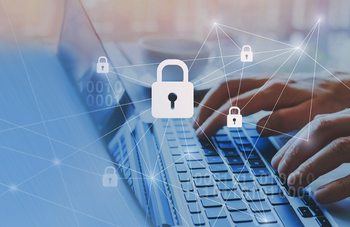All You Need to Know About Cybersecurity

It’s Cybersecurity Month, and that means it’s time to take a long, hard look at how you’re protecting your devices and your data.
Cybercrimes are increasing exponentially by the year. Unfortunately, developments like the pandemic, the growth of cryptocurrency, and the increase in online working and shopping have created a target-rich environment for cyber criminals.
In fact, according to Cybercrime Magazine, cybercrime will cost the world $10.5 trillion annually by the year 2025.
The best way to protect yourself from cybercrimes of any kind is by being aware of common warning signs as well as keeping your systems and devices secure. High levels of cybersecurity are employed at all times on the internet to keep websites–as well as power grids, water systems, and more–running and free of malicious activity. As a private consumer, you can also utilize cybersecurity on your own devices, albeit on a smaller scale. In honor of Cybersecurity Month, let’s take a closer look at this essential toolset and how to best harness it for your protection.
What is cybersecurity?
Cybersecurity refers to the protection of all online devices, networks, data and electronic systems from attacks by hackers, scammers and cybercriminals.
There are several major categories of cybersecurity:
- Network security is the practice of securing a computer network from intruders who commit crimes via targeted attacks and/or malware.
- Application security focuses on protecting software and devices from threats.
- Information security protects the integrity and privacy of data.
- Operational security includes handling and protecting data assets.
- Disaster recovery and business continuity include how an organization responds to an actual or potential security breach.
- Cloud security refers to creating secure cloud applications for companies that use cloud service providers, like Google, Amazon Web Services, etc.
- Identity management and data security protect processes that enable authorization and authentication of legitimate individuals to an organization’s systems.
- Mobile security protects data stored on mobile devices from threats like unauthorized access, device loss or theft, malware, and viruses.
Types of cybercrimes
Cybercrimes can be divided into several categories:
- Cybercrime includes criminals acting alone or in groups who target systems for financial gain or to cause disturbances.
- Cyber-attack will often involve groups of criminals gathering information for political reasons.
- Cyberterrorism is the act of hacking electronic systems with the intent of causing panic or fear.
Methods of cybercrimes
All forms of cybercrimes threaten cybersecurity in some way. Here are some of the methods cybercriminals use to wage attacks:
- Malware. This threat includes ransomware, spyware, viruses, and worms. These can install harmful software, block access to computer systems or provide scammers with access to data.
- Trojans. This attack tricks users into thinking they’re opening a harmless file when, in reality, they’re installing a backdoor that provides cybercriminals with unauthorized access.
- Botnets. This attack is conducted via remotely controlled malware-infected devices and is usually deployed as a large-scale attack. Compromised computers are integrated as part of the botnet system to further spread the attack.
- Adware. This threat involves a potentially unwanted program that is installed without the user’s permission and automatically generates unwanted online advertisements.
- Phishing. This attack is employed via email, text, or social media messages to trick the target into sharing sensitive information. Often, the tactic will also lead to the installation of malware.
- Man-in-the-middle attack. In these attacks, a hacker will insert themselves into a two-person online transaction. The hacker will then steal data and/or login credentials.
How can I protect myself against cyberattacks?
Fortunately, there are lots of preventative measures you can take to protect your information and your money from cyberattacks:
- Update your software and operating systems. Accept every update you are offered because these will provide the strongest and most current protection.
- Use anti-virus software. This software will detect and remove threats in real time.
- Use strong, unique passwords across all your online accounts. Be sure to vary your use of capitalization, symbols, letters, and numbers. For optimal security, switch up your password every six months.
- Never open email attachments or click on links from unknown senders. These can automatically download malware onto your device.
- Avoid using unsecured public WiFi. Using unsecured networks leaves you vulnerable to attacks.
Cybersecurity is a crucial component of modern-day digital safety. This guide can help you learn how to utilize this essential toolset for your personal security.
When you subscribe to the blog, we will send you an e-mail when there are new updates on the site so you wouldn't miss them.
